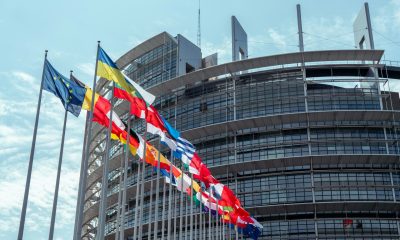Business
The TopRanked.io Weekly Digest: What’s Hot in Affiliate Marketing [Kingfin Affiliate Program]
America is falling apart. Big time. Election year is here, and American values are flying out the window. As is any remaining hope in the American dream. But don’t get scared. Playing into that sort of vibe shift, if you’re smart, is a very powerful way to make some money. So read on to learn what people think is wrong with America, and how you can use those beliefs to make a tidy profit in 2024.
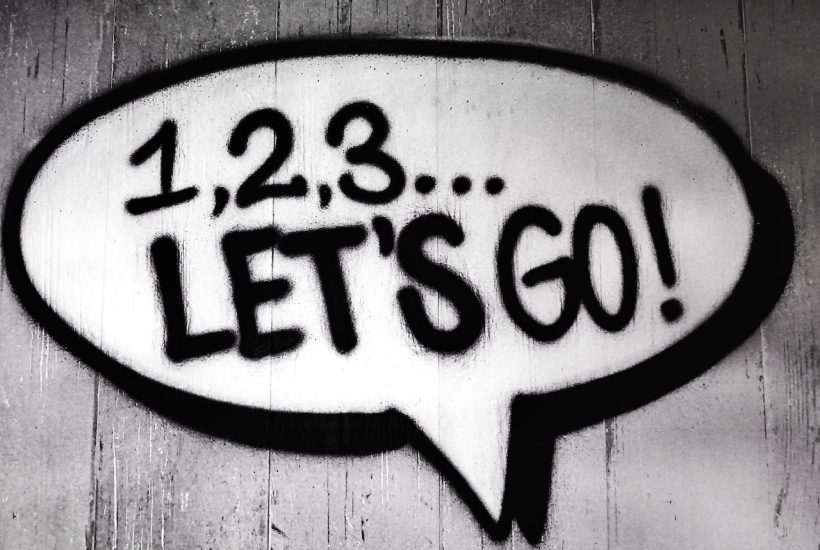
Quick Disclosure: We’re about to tell you the Kingfin afiliate program is pretty great. And we really mean it. Just know that if you click on a Kingfin affiliate program link, we may earn a small commission. Your choice.
Happy New Year kids.

Let’s get down to business.
TopRanked.io Affiliate Partner Program of the Week
Last time we spoke, we brought you a program to take advantage of people’s health-related New Year’s resolutions.
This week, I’d like to bring you another — wealth.
So let me introduce you to Kingfin.

Here’s What Kingfin Is All About
For those who missed the banner, Kingfin is an affiliate program behind some leading fintech brands.
As for what those brands are, Kingfin brings you Doto, and Olymp Trade.
Both are trading platforms, although one (Olymp Trade) has a stronger focus on stocks, while the other (Doto) on CFDs. Both offer Forex.
As for why you might want to work with Kingfin, here are a few points worth considering:
- Kingfin has paid out $23 million to affiliates over the past year (clearly there’s money to be made here).
- Kingfin is available in 150+ countries.
- Kingfin has 9+ years of experience (so you can count on everything running smoothly)
- Kingfin has a high conversion rate
- Kingfin offers a bunch of plans.
As for what those plans are, that comes next when we look at Kingfin commissions.

Kingfin Commissions and Payouts
Kingfin commissions vary depending on the brands you promote, and the plan you opt into.
More precisely Kingfin offers Commission per lot and RevShare for affiliates promoting Doto. And for affiliates promoting Olymp Trade, there’s RevShare, CPA, and hybrid.
As for what this nets you, I’m just going to steal the words off of our full Kingfin Affiliate Program Review (on TopRanked.io):
With the Kingfin Affiliate Program, you can earn up to $150 CPA commission and up to 60% of the broker’s profits from referred users.
As for payouts, Kingfin offers 15+ payment options, including Skrill, Bitcoin, and the more traditional Wire Transfer.
What’s the Downside With Kingfin?
Frankly, there isn’t much downside to working with Kingfin. There is the little detail of a $500 minimum payout when you’re working on the CPA plan. But, with $150 on offer, that’s not a whole lot of conversions you need to make to get it.
And, if you work with Kingfin on rev share, the minimum’s a more reasonable $10. And then there’s also the little detail of bonuses and incentives (up to $15k for top affiliates).
So really, there’s not much that should stop you from working with Kingfin.
If you want to find out more, visit TopRanked.io for our full Kingfin Affiliate Program Review.
Or just go straight to the source and visit the Kingfin Affiliate Program for yourself.

[The not-so] Closing Thought
This week, I’m shaking things up and sticking the closing thought in the middle.
Why’s that?
Because what comes next in the news section may or may not paint a pretty picture of the state of America.
As a preview, it’s grim. Some might even say pessimistic.
But that will depend on how you read it.
And I don’t want you to read it in a pessimistic way.
You see, we humans have a tendency to frame everything in terms of optimist vs pessimist.
Glass half full vs glass half empty.

But I want to offer you a different take.
Many years ago, there was a philosopher named Gilles Deleuze. He wrote an essay titled Postscript on the Societies of Control.
In it, he spells out a “generalized crisis” in relation to the old “disciplinary societies” — the mainstay institutions like our schools and armed forces that “disciplined” us into being good citizens.
He then paints a picture of how we are moving from more “enclosed” and “rigid” institutions (school, military) towards more “fluid” and “pervasive” ones. For example, he uses an “electronic card” as an analogy, where “what counts is not the barrier but the computer that tracks each person’s position–licit or illicit–and effects a universal modulation.” (This was written in the 90s… try replacing “electronic card” with “social network”.)
As for why I’m bringing this essay up here, that’s simple.
In that same essay, he also says we shouldn’t fear these changes:
“There is no need to ask which is the toughest regime, for it’s within each of them that liberating and enslaving forces confront one another… There is no need to fear or hope, but only to look for new weapons.”
And that is a useful way to think about many things.
There is no need to be optimistic or pessimistic.
There is always a downside.
And there is always an upside.
Your job is to land on the upside. (And yes, there is a way to land on the upside of all the incoming “pessimism”.)
PS: Landing on the upside is a whole lot easier if you have a good affiliate program on your side. Kingfin can help here.

News Takeaways — There’s a Serious Vibe Shift in America
On December 26, the results of a recent JL Partners poll were published.
Specifically, a couple of word clouds, showing the words that people most associate with our two main 2024 presidential candidates — Sleepy Joe Biden, and Donald “Golden Shower… uh, I meant… Tower” Trump.
Here’s Trump’s, as proudly shared by the man himself.
Now here, there are a few “shocking” things.
First, who publishes word clouds anymore?
And second, what kind of Presidential candidate leans into something like this, and somehow manages to come out completely unscathed in the polls? (In case the “Composed Truth” embed isn’t loading, the three biggest words in the center of Trump’s cloud are “revenge, dictatorship, and power”.)
Now, don’t get me wrong here. When I say this is shocking, this isn’t to pass judgment on Trump — love him, hate him… you do what you want.
Instead, I want to look at this from a “What’s going on in America?” perspective.
After all, I have a sneaking suspicion that, if a US presidential candidate was taking pride in sentiment he was a vengeful, power-hungry dictator, they would have at least taken a small hit in the polls. (I’d speculate that, once upon a time, it would have been a very big hit.)
I mean, haven’t years of red scares, anti-China rhetoric, North Korean/Cuban embargos, and other things taught us that cults of personality combined with dictatorial tendencies aren’t compatible with American values?
So what’s going wrong in America?

Let’s explore one theory, starting with a couple of observations about the American dream and American values.
The American Dream Is Dying
In October last year, the WSJ in tandem with NORC conducted a poll. Here’s the headline finding.
Question: “Do you think the American Dream–that if you work hard you’ll get ahead–still holds true, never held true, or once held true but does not anymore?”
- Still holds true (36%)
- Never held true (18%)
- Once held true but not anymore (45%)
- not sure/skipped (1%)
Then, in November, NBC News published this survey. Here’s the headline finding.
Question: “Do you feel confident or not confident that life for our children’s generation will be better than it has been for us?”
- Confident (19%)
- Not confident (76%)
- Not sure (5%)
What’s interesting here is that NBC has been running its survey for a while now.
Here are some previous responses to the same question.
1990
- Confident (50%)
- Not confident (45%)
- Not sure (5%)
2001
- Confident (49%)
- Not confident (42%)
- Not sure (9%)
2009
- Confident (31%)
- Not confident (57%)
- Not sure (12%)
So here we find ourselves in an America where 63% of the population no longer has faith in the American Dream.
And only 19% of people believe that the next generation will be better off — a historical low by a long shot.
That’s a very pessimistic country.

And that’s just the start.
American Values Are Dying Even Quicker
In March last year, the Wall Street Journal in tandem with NORC surveyed American values.
And by American values, we’re talking about patriotism, community, religion, children, and community involvement. You know the sort — good, wholesome things that, for the most part, are vital to the health of any nation, no matter where you stand on the political spectrum.
And now here are the trends over the last couple of decades that the WSJ found.
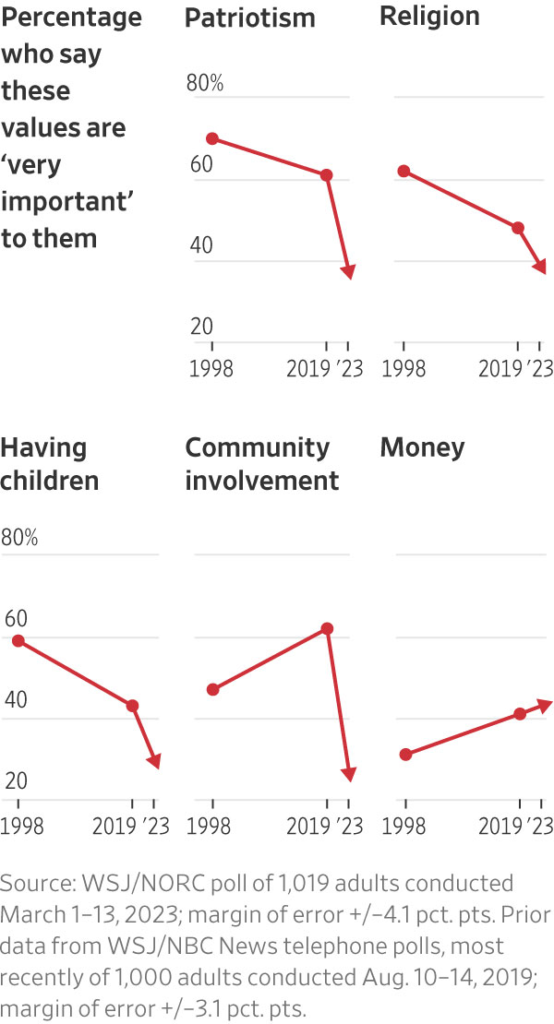
Not shown in the graphs, there was also (to quote the WSJ directly), “Tolerance for others, deemed very important by 80% of Americans as recently as four years ago, has fallen to 58% since then.”
So basically, the only American value that hasn’t dropped off a cliff is money.
How did we all get so cynical?
The Easy Answer — Identity Politics
Once upon a time, the greatest divide in the nation was the class war.
And no matter what side of that war you wanted to take, I’m sure we can all agree on one thing. It’s the sort of good, wholesome stuff that can at least help to unite the masses around a common cause.
But, today, “the class war is dead.” Instead, we now have the culture war.
So, in some ways, it’s no surprise that values like “tolerance for others” have taken a tumble.
On the one hand, you have an entire population who are being told that they’re the victims of another population’s oppression — why be tolerant of your oppressor?
And on the other hand, you have the other population who’s being told they’re over-privileged, racist, despicable people — so why be tolerant of those who hate you for your immutable identity?
Dito for wanting to get involved in your community, or feeling patriotic about your country. It all kinda makes sense, right?

But, at the same time, it kinda doesn’t.
For example, why would the desire to have children also drop off a cliff? And can a culture war really make patriotism fall off a cliff so sharply?
Maybe there’s something else going on.
Optimism vs Pessimism
Let’s go back to the first batch of surveys highlighting the death of the American dream. None of those findings are easy to correlate with culture wars.
But they do show America is more pessimistic than it’s ever been. So what gives?
To answer that, there are a thousand places we could look to find the root of all pessimism. But, maybe one good place is to start by asking “what do we have to be optimistic about?”
And for that, there’s maybe no easier place to turn to than the essay that set the world on fire last year — Marc Andreessen’s Techno-Optimist bible.

In it, he made all sorts of bold optimist claims.
“We had a problem of starvation, so we invented the Green Revolution.”
“We had a problem of isolation, so we invented the Internet.”
“We have a problem of poverty, so we invent technology to create abundance.”
Basically, there’s no reason not to be an optimist, right? America is an innovative country that will innovate its way out of every problem.
And, depending on how you squint, he’s right.
But, if you squint another way, he’s off the mark (excuse the pun) by a bit.
Let’s tackle a few of them.
On the Green Revolution thing, it’s true that we “solved” the starvation thing. Researchers have said that “the total food available per person in the world rose by 11 percent… while the estimated number of hungry people fell… 16 percent.” But, at the same time, the “American diet is deadly”. And it’s not just poor food choices — there’s also been a corresponding nutrient decline as faster-growing, higher-yielding crops took over the world.
Guess you win some, you lose some.
On the loneliness thing, yes, we’re technically more connected than ever thanks to the internet — there’s no argument here. But, at the same time, we’re somehow in the midst of what some are calling a loneliness pandemic as we replace strong social connections with engagement metrics. (Or however you want to explain it…)

Again, you win some, you lose some.
And when it comes to poverty, there are a couple of popular data points that often get pulled out to support the optimist case.
The first is that we have, indeed, reduced the number of people living in extreme poverty over the last few decades.
The second is that the Median American household income has increased. To steal a 2023 headline from a Cato Institute article highlighting this fact, “Upward Mobility Is Alive and Well in America”.
But, again, here we have another “you win some, you lose some” situation.
For now, we can ignore the extreme poverty stats — for most Americans, starvation and extreme poverty haven’t really been a concern at any point in their lifetimes.
But the rising household incomes — that is a tricky one.
Yes, the data checks out — household incomes have increased over previous generations. But that only tells part of the story.
Here’s the inflation-adjusted data from 1970 to 2018.

Or, to put that into words, inflation-adjusted household incomes fell in the wake of the dot-com bubble, failed to recover by the GFC when they fell again, and only hit “growth” almost twenty years later in the late 2010s.
And now, you have the “cost of living crisis”.
Then we also have the small issue that increasing household incomes have largely been supported by the growing number of dual-income households. That, and a few other things like the rise of shared living arrangements and the trend of young adults living with their parents longer, which has been rising sharply since about the 90s.
And at the same time, the inflation-adjusted cost of the things that actually matter — housing, education, health care, etc. — has only continued to creep up for decades. Again, the recent “cost of living crisis” has only exacerbated this.
And let’s not forget that other “quality of life” indicators have also been falling.
Take life expectancy, for example. While the headlines today are trumpeting a dramatic decline due to Covid-19, that had already been falling before COVID-19. In fact, between 2015 and 2020, the first drop in life expectancy in the US since WWI was recorded. That was “attributed to negative societal trends… high medical costs, and increasing rates of suicide and drug use.”
So maybe there’s a bunch of stuff that’s killing hope in the American dream.
Americans Are, Just Maybe, Desperate For Something to Believe In
When we see an increase in American pessimism and a decline in American values, it would be totally understandable if people are more desperate than ever to find something to believe in.
And, sadly, techno-optimism probably ain’t gonna cut it for most.

After all, what did the techno-utopianism of the late ’90s “California Ideology” bring about for the average American? Mass surveillance, hostile digital takeovers of entire markets, and false dreams of a “people can now do the work they love” gig economy?
Oh right. They at least have cheap gadgets and 24/7 streaming services.
Again, you win some, you lose some, but what we “won” here is, arguably, fast losing its ability to distract the average American from the fact that the real American dream. iPhones and streaming media are a poor stand-in for the ability to support a stay-at-home wife (or husband if that’s your thing), a dog, and “2.5 kids” on a single income.
And I doubt calling people “doomers” or “decels” is going to lift spirits any time soon.
So what do people have left to believe in?
A man who says he’s going to make America great again?
Yeah, that might work.
And, if those people are just desperate enough and have already given up on the rest of their values, then who cares if the cost is the most extreme interpretation of unitary executive theory possible?
It sure sounds better than the alternative — “nothing”.

Takeaway
If you’ve been paying attention over the last few years, then you would have noticed the culture wars meant one thing.
Money.
Some people made it.

While others lost it.

But now, it seems, a few other things are bubbling over into the American consciousness as faith in American values and the American dream nosedive to shocking lows.
In short, people are more anxious/pessimistic than they have been in a long time. And it’s about a lot more than just woke g-men forcing us to use the right pronouns.

In short, people are just giving up hope altogether.
And that sentiment, if you harness it wisely, can be a very powerful thing to tap into.
Especially in an election year where all of these issues are going to be more top of mind than usual.
As for how you can take advantage of this, I’m not even going to bother explaining this one.
If you can’t figure out how to market something from Kingfin to a nation that’s not only anxious about money, but also holds it as its last true value (money is the only American value that trended up)… well, then maybe it’s time to give up on being an affiliate.

__
(Featured image by SevenStorm JUHASZIMRUS via Pexels)
DISCLAIMER: This article was written by a third party contributor and does not reflect the opinion of Born2Invest, its management, staff or its associates. Please review our disclaimer for more information.
This article may include forward-looking statements. These forward-looking statements generally are identified by the words “believe,” “project,” “estimate,” “become,” “plan,” “will,” and similar expressions. These forward-looking statements involve known and unknown risks as well as uncertainties, including those discussed in the following cautionary statements and elsewhere in this article and on this site. Although the Company may believe that its expectations are based on reasonable assumptions, the actual results that the Company may achieve may differ materially from any forward-looking statements, which reflect the opinions of the management of the Company only as of the date hereof. Additionally, please make sure to read these important disclosures.

-
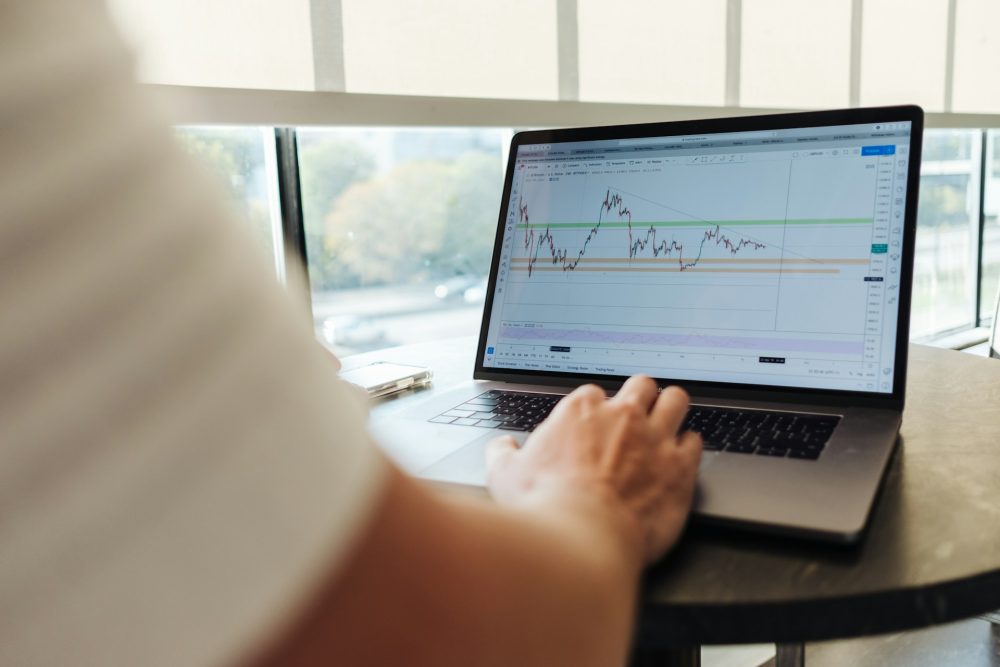
 Africa1 week ago
Africa1 week agoBank Al-Maghrib’s Final 2025 Meeting Expected to Maintain Key Interest Rate
-
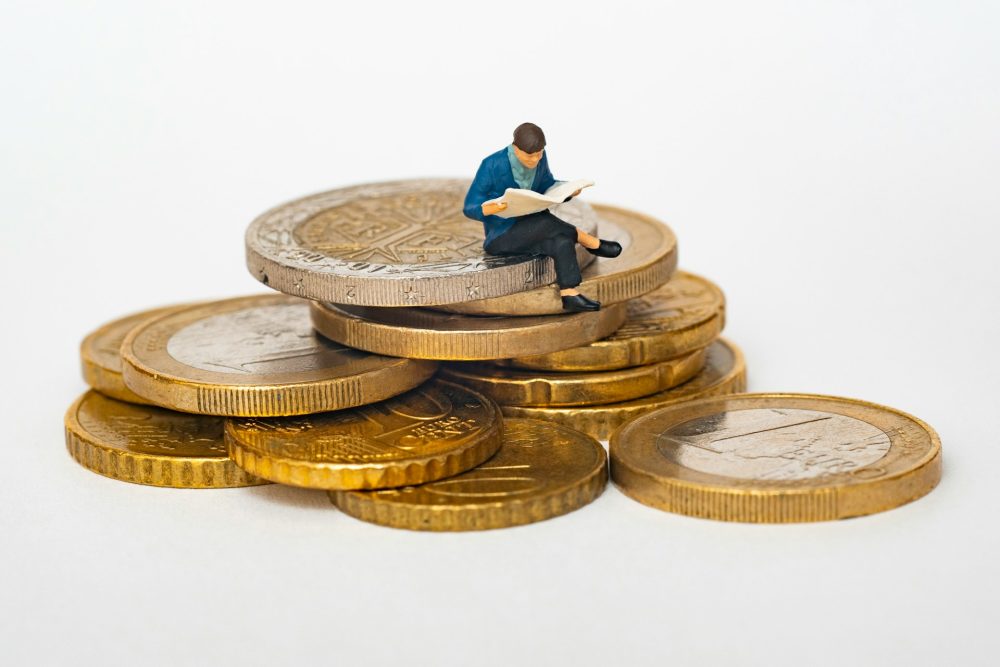
 Crowdfunding2 weeks ago
Crowdfunding2 weeks agoOpstart Unifies Crowdlender: A Streamlined, Wallet-Free Investment Hub Launches December 2025
-

 Africa3 days ago
Africa3 days agoMorocco Allocates 1.3 Billion Dirhams to Boost Startup Ecosystem Under Digital 2030 Strategy
-

 Crowdfunding1 week ago
Crowdfunding1 week agoStar Citizen Funding Soars as 2025 Becomes Its Most Successful Year Yet








